A Beginner's Guide: Everything To Know Before Your First Tattoo
A Beginner's Guide: Everything To Know Before Your First Tattoo
Getting your first tattoo is an exciting milestone – especially after days, months or even years spent looking and lusting over design inspiration. The anticipation of your first tattooing experience can bring up mixed emotions. On the one hand, you’re eager to add this piece of artwork to your skin. Your chosen tattoo design may hold sentimental value (e.g. a tribute to a family member), highlight a particular character trait (e.g. zodiac tattoos, birthday dates or other significant numbers), or serve as a way to showcase your interests and feel more attuned with your innate creativity. On the other hand, it is normal to worry about the pain and the discipline required during the tattoo healing process. Following proper preparation and after-care instructions is essential to minimize pain and prevent infection, scarring or premature tattoo fading.
Expert Tip: Zensa Numbing Cream contains 5% lidocaine for maximum-strength pain reduction during your tattooing session. Many artists don’t like most tattoo numbing creams because they include vasoconstrictors, which temporarily alter your skin texture, disrupt ink settling and can ultimately distort the final look of your piece. However, Zensa Numbing Cream does not contain any vasoconstrictors to provide a more pleasant tattooing experience without worrying whether some temporary relief will ruin the ink’s vibrancy or look of the final piece. Our unique vegan, cruelty-free formula won’t affect ink settling and contains vitamin E for anti-inflammatory benefits that begin to support the healing process even before you leave the studio chair.
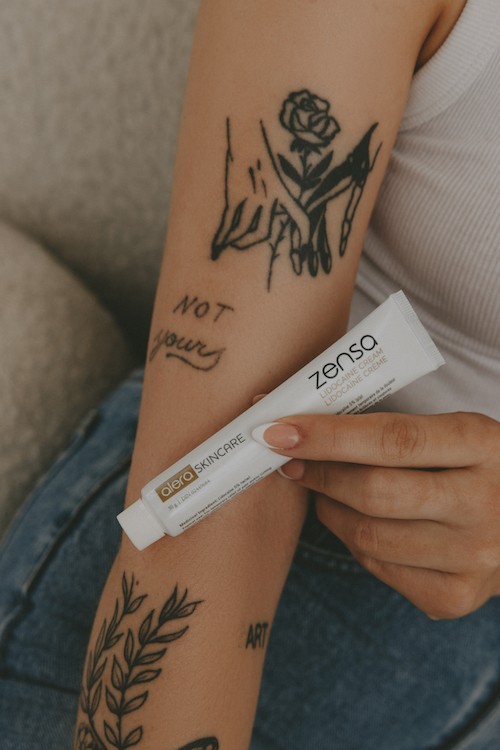
Here is a beginner’s guide to everything you should know before getting your first tattoo (and a refresher for additional ones in years to come). Read on for the best tips on:
-
How To Select The Right Tattoo Artist
-
How To Prepare For Your First Tattoo
-
Tattoo Preparation Do’s & Don’ts
-
What To Expect At Your First Tattoo Session
-
How To Prevent Pain When Getting Your First Tattoo
-
What To Expect When Sitting For Your First Tattoo
-
Tattoo After-Care: The First 48-72 Hours
-
Tattoo After-Care Do’s & Don’ts
-
Normal Side Effects vs. Signs of An Infected Tattoo
-
Overview of The Tattoo Healing Stages

How To Select The Right Tattoo Artist
Be discerning with who you choose to engrave permanent ink into your skin. Do your research on the best tattoo artists in your local area. Read reviews or, better yet, ask for a referral from a trusted friend, family member or coworker. Dive into every vetted expert’s portfolio on their website or Instagram feed. Remember: Tattoo artistry is as much a creative endeavor as it is a medical procedure. Validate your tattoo artist’s license, the studio’s permit credentials and client experiences regarding the staff’s adherence to strict health and safety regulations.
Any tattoo artist you consider booking an appointment with should have work examples similar to your desired results and a proven track record of following proper hygiene protocols. Feel free to call before making an appointment to ask any questions you have about the studio and tattooing experience to ensure you feel comfortable with your chosen expert and establishment.
How To Prepare For Your First Tattoo
Pay extra attention to your skincare and hygiene practices for the week (or two) before your tattoo appointment. Shave the soon-to-be tattooed area 2-3 times per week before your tattoo appointment and for the final time 48-72 hours before your scheduled session. Let your artist know if you’re not comfortable with shaving your skin by yourself. They will advise whether this practice is necessary for your desired placement and if they can shave it for you beforehand.
Exfoliation is essential for tattoo preparation. This practice removes dead skin cells along the top layer of skin (epidermis) to leave the area clean and smooth. Exfoliate gently using a loofah, glove or brush sponge 1-3 times weekly in the 7 days ahead of your session (including the night before or the morning of your tattoo appointment). Thoroughly cleanse and moisturize your skin daily (as you should regardless of whether you’re getting a tattoo). Never get a tattoo when you have dry, flaky skin. If you’re prone to extremely dry or cracked skin, plan on booking your tattoo session during the warmer months instead of in the winter.
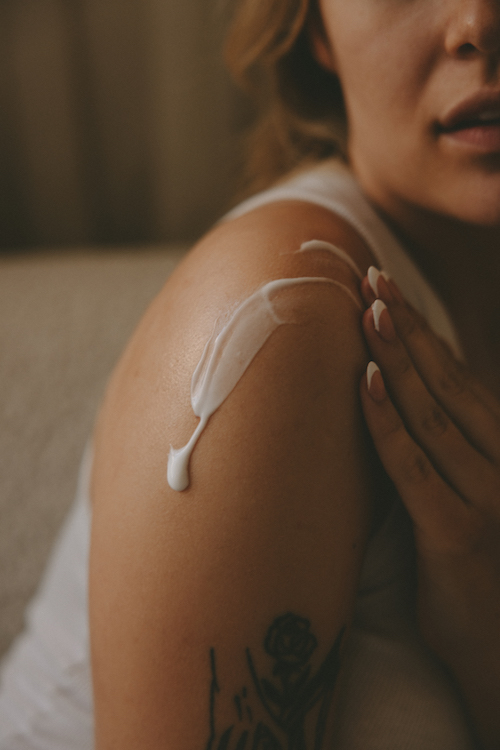
Use a gentle body wash to clean your skin, exfoliate and apply a nourishing moisturizer with especially hydrating ingredients like aloe vera, glycerin and hyaluronic acid. Zensa Healing Cream contains these three ingredients alongside medicinal-grade calendula oil and grapefruit essential oil to increase cellular turnover and stimulate collagen production to strengthen the skin barrier and prime your skin for accelerated wound healing during the tattoo after-care stages.
Despite the common myth that these practices make little difference, exfoliating and moisturizing your skin regularly do considerably increase the absorption rate of a topical anaesthetic right before getting a tattoo. “Cleaning and exfoliating the skin before applying a topical anaesthetic is one of the most effective things you can do to help out the absorption of your topical anaesthetic,” said Aly Lalani, our in-house topical anaesthetic expert. “Because the epidermis (the top layer of the skin) is the toughest layer for a topical cream to absorb through, removing its outer layer through exfoliation greatly enhances its absorption capability.”
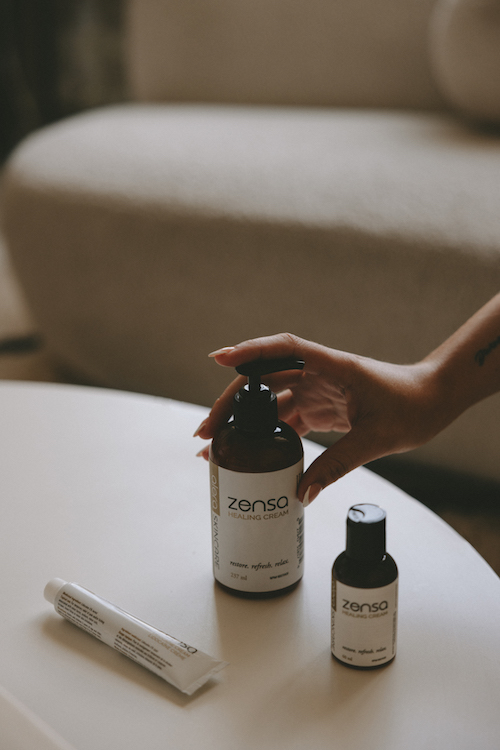
Tattoo Preparation Do’s & Don’ts
What To Do Before Getting A Tattoo (Within the 1-4 Weeks Before):
- Keep Up A Nourishing Skincare Routine (Cleanse, Exfoliate, Shave, Moisturize)
- Stay Hydrated (Drink At Least The Number of Ounces = Your Weight in Pounds of Water Daily)
- Maintain A Healthy Diet (Focus On Foods Rich in Omega 3, Vitamin C and E)
- Wear Sunscreen Daily (At Least SPF 50) & Cover Up Your Skin)
What To Do Before Getting A Tattoo (24 Hours Before & The Day of Your Appointment):
- Get A Good Night’s Rest (Show Up To Your Appointment On 7-8 Hours of Sleep)
- Eat A Satisfying, Well Balanced Meal (Within 4 Hours of Your Session, Have a Snack Right Before Getting Your Tattoo If Desired)
- Calm Your Mind (Go For a Walk, Meditate, Journal, Listen To Music or Do Yoga To Ease Anxiety)
- Arrive Freshly Showered (Cleanse, Exfoliate & Moisturize Your Skin The Day Of Your Appointment)
- Have Reference Photos Ready (Keep Your Design & Tattoo Inspiration Images On Your Phone To Share With Your Artist)

What To Avoid Before Getting A Tattoo (Within the 1-4 Weeks Before):
- Stay Out of The Sun (Don’t Tan or Sunburn)
- Avoid Tanning Beds (1-2 Weeks Before Your Tattoo)
- Don’t Take Blood-Thinning Medications, Such As Aspirin, Fish Oil or Vitamin E Supplements (1 Week Before Your Tattoo)
What To Avoid Before Getting A Tattoo (24 Hours Before & The Day of Your Appointment):
- Don’t Drink Alcohol or Consume Caffeine (Within 24-48 Hours of Getting A Tattoo)
- Skip The Workout (No Intense Exercise – Avoid Any Sweat-Inducing Activities)
- Avoid Wearing Tight Clothes (To Your Appointment)
- Don’t Confirm An Appointment If You Have Cracked or Damaged Skin (Any Bruises, Cuts, Peeling, etc.)
- Avoid Canceling Last-Minute (Notify The Studio At Least 24 Hours Before If Possible)
What To Expect At Your First Tattoo Session
Arrive at your tattoo appointment freshly showered with exfoliated and moisturized skin, wearing comfortable and loose-fitting clothes. Ensure that you arrive on time for your appointment, so your artist can have the area clean and all the equipment sterilized promptly for you and their other clients for the rest of the day. Come prepared to show your photo ID (you must be at least 18 years old in the U.S. and Canada to legally get a tattoo) and fill out any consent forms.
Once you finish the paperwork, it’s time to consult with your tattoo artist on the details of your piece. For clients getting a custom design, you should already have had an in-depth consultation with your artist before your formal appointment and have been shown the initial mock-up before the revision process. During this brief consultation, your tattoo artist will share a mock-up with you to finalize the details for your future tattoo. Having some of your inspiration on hand can be helpful during this review process, so your artist can best conceptualize your vision for the final piece without relying on words or brief descriptions alone.
Size also matters when approving the final design. Smaller tattoos do not necessarily hurt less than larger ones. Pain is often dictated by the placement – not the proportions – of the tattoo ink. Sometimes, certain letters, numbers or small features of a design need to be enlarged, so they appear crisp and clear once healed.
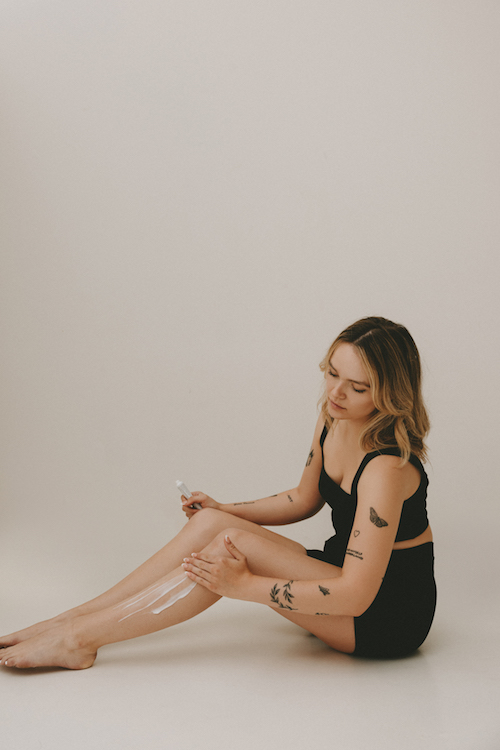
How To Prevent Pain When Getting Your First Tattoo
If you elect to use a topical anaesthetic, like Zensa Numbing Cream, your tattoo artist will need to ensure there’s enough time to let the product sit and allow the lidocaine’s numbing sensation to activate. Zensa Numbing Cream should be applied 30-45 minutes before tattooing. Cover it immediately with saran wrap to increase its absorption rate. Take off the wrapping and wash off the numbing cream right before stenciling your tattoo.
Once the final design is approved and the numbing cream has had a chance to sit and activate, it’s time to do the stencil placement (an outline of a piece drawn onto the skin before any ink gets involved). Stenciling your tattoo is important, so you know exactly how the tattoo will look on any given area you desire. Especially when getting your first tattoo, it’s normal to have your stencil redone a few times before sitting for your tattoo. You’ve probably been idealizing a specific placement for quite some time now and need to confirm whether your expectations match up with how the design looks in real life. Your artist may advise certain tweaks to your ideal placement, so the image doesn’t get distorted by natural bodily movements during the healing process and long term. Try to stand in front of the mirror and gently move around with your stencil design to see how the tattoo will hold up in daily life.
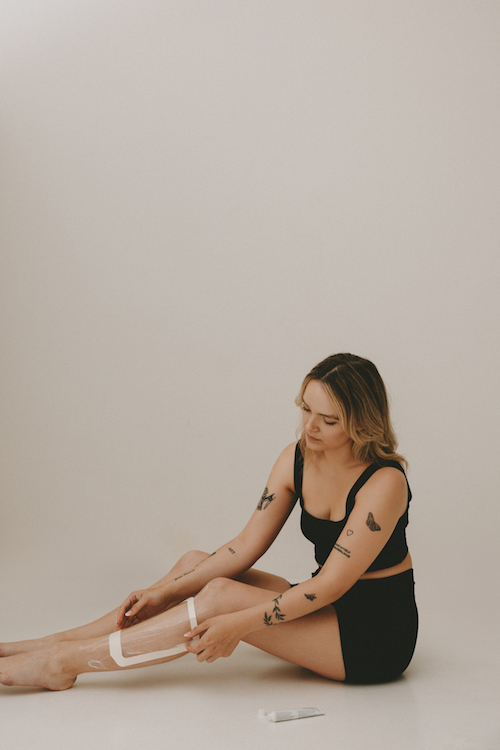
What To Expect When Sitting For Your First Tattoo
Sitting for your tattoo is the most intimidating part. Breathe. The process can take anywhere from 30-60 minutes to several hours, depending on the size and intricacies of the piece. Highly extensive tattoos – like a full sleeve – will be done over a few sessions. Don’t be surprised if your artist makes a deliberate effort to set up all of their supplies under your watch. This is a common practice among tattoo artists to ensure their clients see that they’re using all new, sterile, straight-out-of-package tools.
Try to remain as still as possible once your artist turns on the machine. Do your best to relax your mind and muscles. Sit or lie down in a comfortable position while still following your artist’s directions. Expect the first few minutes of the tattooing process to be the most painful. After the initial shock, your body will build up some resilience to the pain (and it will hurt even less with the use of a numbing cream), so you can tolerate the time it takes to complete the piece.
Remember, though, it is normal to take breaks during your tattoo session and not have the entire design finished in one go. Tell your tattoo artist if you start to feel light-headed, have high levels of discomfort or are generally unwell throughout the procedure. Your artist can then stop the tattooing process for a few minutes before continuing to work on your piece. Some artists will engage in light conversation to help take your mind off the pain. However, other artists find talking while tattooing to be too distracting and need to work in silence to focus. You should be able to gauge how talkative your artist will be fairly early on in your tattooing experience.
Once your tattoo is finished, your artist will wrap it up with a tattoo after-care bandage (like Saniderm) or cling film. When settling the payment, always make sure to tip your artist before leaving your appointment. It is considered a standard courtesy to tip your tattoo artist between 20-30% of the service price.
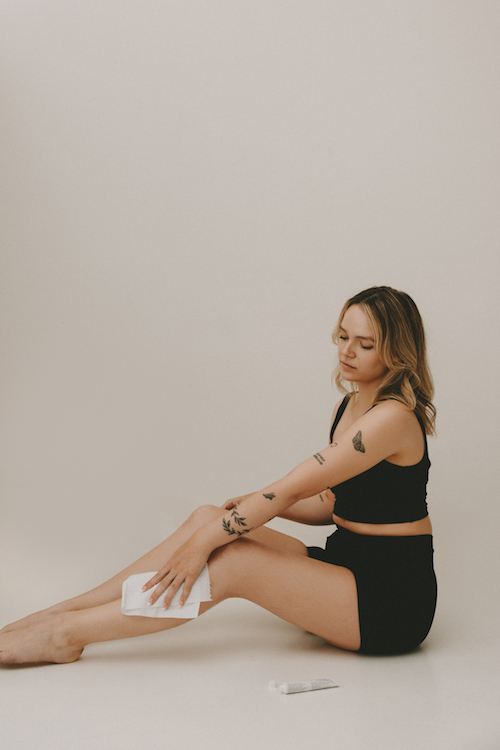
Tattoo After-Care: The First 48-72 Hours
Tattoo artists widely consider protective tattoo film – products like Saniderm or Derm Shield – to be superior to cling wrap for covering a new tattoo. Saran wrap should never be used on a new tattoo as it is a health hazard for this common household product to come into contact with a fresh wound (even though this malpractice was popular for decades). While it depends on your unique piece, placement and covering used, most tattoo wraps need to be replaced at least once every 24 hours for the first 1-3 days of the healing process. Monitor your wrapped tattoo to ensure there’s no fluid build-up. If you see any oozing or considerable discharge from the fresh wound, remove the covering and clean the skin immediately.
It is normal to feel slightly under the weather for the first 48-72 hours after getting a tattoo. Remember: A fresh tattoo is an open wound, so it’s essential to keep it dry, covered and clean to prevent infection, minimize scarring and generally support the healing process.
After 24 hours, your tattoo will likely still be sore and appear similar to a sunburn (red and inflamed). Wash your hands thoroughly before touching the area surrounding the fresh tattoo. Remove any protective tattoo film and wash your tattoo with a specialty tattoo cleanser or a gentle, fragrance-free antibacterial soap and lukewarm water. Gently pat the area dry with a fresh paper towel. By the 24-hour mark, you can start moisturizing your new tattoo. Use a tattoo lotion, like Zensa Healing Cream or a hydrating ointment like Aquaphor (if you need an alternative drugstore option).
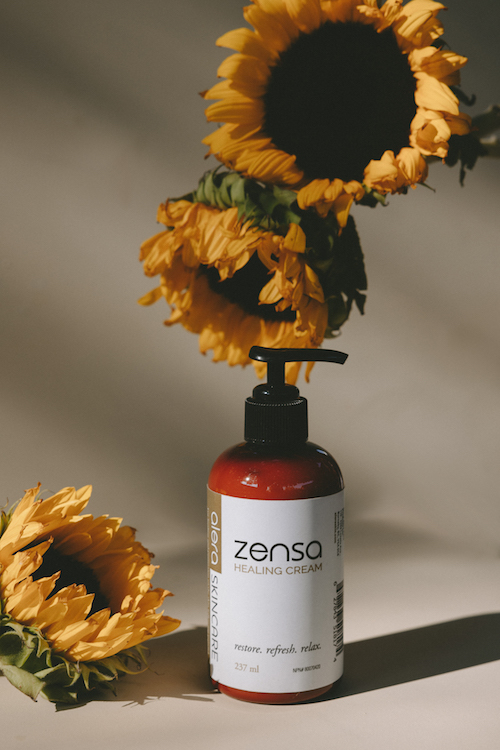
Zensa Healing Cream contains medicinal-grade calendula oil and grapefruit essential oil for anti-inflammatory and skin hydration benefits, like reducing irritation and speeding up tattoo healing. Its other nourishing ingredients include shea butter, cucumber extract and aloe vera to moisturize and soothe the skin. Zensa Healing Cream also contains sunflower seed oil to brighten and preserve the tattoo’s colour without impeding ink settling.
If recommended, cover your tattoo and change the protective wrap as needed. Continue to wash and hydrate your tattoo once or twice daily – depending on your artist’s specific tattoo after-care instructions.
Tattoo After-Care Do’s & Don’ts
Best Tattoo After-Care Practices:
- DO: Establish A Consistent Hygiene Routine (Cleanse and moisturize your tattoo 1-2 times daily for 4-6 weeks.)
- DO: Keep Your Tattoo Hydrated (Apply a thin layer of a hydrating ointment or tattoo lotion, like Zensa Healing Cream, as needed to keep the skin smooth, supple and prevent cracked or dry, itchy skin.)
- DO: Stay Dry Whenever Possible (Always gently pat your new tattoo dry with a fresh paper towel after cleaning the area or getting out of the shower. Avoid steamy showers, saunas, public pools or bodies of water for around 6 weeks.)
- DO: Frequently Change Your Towels & Sheets (Make sure to use a fresh set of sheets and towels on the first night after receiving your new tattoo. Use linens that you won’t mind throwing away after 1-2 days as the ink could permanently stain these items. Consider using a Saniderm bandage to manage any tattoo weeping during the first 48-72 hours of the tattoo healing process. Always consult with your artist for their recommendations on the best nighttime after-care practices for your specific piece.)
- DO: Wear Loose-Fitting Clothing (Garments constructed in relaxed silhouettes allow your skin to breathe and won’t rub against the fresh ink, which could damage the vulnerable tissue or trap moisture and lead to an infection. Cotton and organic cotton are the best fabrics to wear after getting a new tattoo.)

What To Avoid During The Tattoo After-Care Process:
- DON’T: Leave On Your Initial Tattoo Bandage For Long (Wait at least 3-4 hours after leaving the studio to remove this covering, don’t leave a standard tattoo bandage on for too long before cleaning and re-wrapping it, if instructed by your artist. However, breathable protective tattoo film wraps– like Saniderm tattoo bandages– are designed to cover your ink for 8-24 hours at a time.)
- DON’T: Pick At Your Scabs (Keep your hands off your peeling skin – unless they’re clean and purposely there to cleanse or hydrate the area. Picking at your scabs can leave you more susceptible to infection, cause scarring or result in a patchy tattoo.)
- DON’T: Soak, Steam or Sweat With Your New Tattoo (Refrain from taking hot showers, baths, engaging in intense exercise, swimming or any sweat-inducing activity right after getting a new tattoo.)
- DON’T: Get Direct Sun Exposure (UV rays can damage the healing skin, dry out the area and prematurely fade your new tattoo. You can’t apply sunscreen on an open wound, so always cover the freshly-inked skin with relaxed-fitting clothing when stepping outside.)
To learn more, read our full guide on the do’s and don’ts to follow during the tattoo healing process.
Normal Side Effects vs. Signs of An Infected Tattoo
While some redness, soreness, itchiness and peeling are all normal side effects of the tattoo healing process, keep a close eye on any symptoms that cause genuine discomfort or distress. More severe side effects that involve excess fluids or have you feeling very unwell could be signs of an infected tattoo. Here are the symptoms of an infected tattoo to look out for during the initial healing stages:
- Rash or Red, Bumpy Skin
- Increased, Severe Skin Swelling
- Pus Coming Out Of The Tattoo
- Red Streaks Throughout The Tattoo
- Increased Pain
- Sections of Hard, Raised Tissue
- Fever
- Hot & Cold Flashes
- Shivering Or Chills
Seek medical attention immediately if you’re experiencing any or several of these symptoms.

Overview of The Tattoo Healing Stages
It is normal to feel slightly under the weather for the first 48-72 hours after getting a tattoo. After around 72 hours, you should start to feel better and enter a new stage of the healing process. On day 3, expect your tattoo to have a cloudy appearance from scab formation. This is a sign that your skin is repairing itself. The bleeding and drainage should subside by day 3 or 4.
For days 4-7, scabs should continue forming and thickening over your tattoo. Make sure to be diligent about your after-care routine during this first week. Wash, pat dry, and moisturize the tattoo once or twice daily. The following healing stage often starts during days 7-14 of the tattoo healing process. Your tattoo will peel from around day 7, to 2 weeks after getting your tattoo. During the peeling stage, it is normal for your skin to feel dry and itchy. Resist the urge to scratch and make sure your skin is well moisturized.
Tattoo lotions, like Zensa Healing Cream, are designed to reduce itching, minimize scarring, infection and tattoo fading or patchiness. Never pick, peel off, or scratch your scabs throughout the healing process. Picking at scabs on a new tattoo can pull the ink out and lead to a patchy tattoo, scarring, a reopened wound or potential infection. After 2 weeks, the dead skin cells should exfoliate themselves away to unveil a fresh layer of healed skin. Your tattoo should be fully healed after around 4-6 weeks.
Read more about what to expect during the tattoo after-care process day by day.
